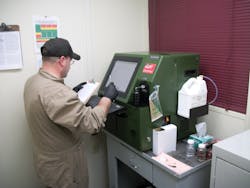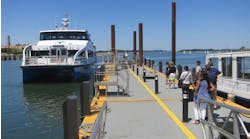Kitsap Transit, based in Bremerton, Washington, and serving the county of Kitsap, operates routed bus service, foot ferry service and service for elderly and disabled passengers. The agency has long been concerned with preventing engine failures and optimizing maintenance schedules for its fleet of approximately 362 pieces of equipment, including transit buses, cutaway small buses, vans and three passenger-only ferries.
Previously, the maintenance department monitored the engines of vehicles in its fleet by sending oil samples to an outside laboratory. The analyses provided measurements of heavy metal content, fuel and radiator fluid contamination, etc. The problem with this approach was cost and time: it cost $40 per sample using a third-party lab and took 14 to 21 days to receive the results. The cost limited the number of samples that were analyzed and the lead time created the possibility that a failure might occur before the results were received.
Kitsap Transit purchased an OSA4 TruckCheck automated oil analysis system from Spectro Scientific in 2014. The system enables the maintenance team to perform analysis on-site of oil samples previously done in the lab including Total Base Number results for less than $1 per sample in less than 30 minutes.
“Bringing oil analysis in house made it possible to begin analyzing all of our bus engines on a regular basis,” said Dennis Griffey, maintenance supervisor with Kitsap Transit. “Within the first few months, the analyzer identified two engines that were close to failure. We saved about $40,000 by eliminating the need for an out-of-frame rebuild in one case and by getting the rebuild done by the dealer as part of the warranty in the other.”
Kitsap Transit has approximately 150 buses in its fleet. The agency operates 43 bus routes and ferry service from Bremerton to Port Orchard, Washington. Kitsap Transit’s Access service provides door-to-door and curb-to-curb service for the elderly and disabled. It runs 32 worker/driver commuter routes operating to and from the Puget Sound Naval Shipyard and Naval Base Kitsap/Bremerton in which the drivers are full-time shipyard employees. The agency’s fleet includes nine 2012 Arboc, 17 2010 Arboc, 2 2003 ElDorado, 45 Gillig models from the 2000s and 42 MCI worker/driver coaches from the 1990s, 50 e-350 and e-450s, 11 g-4500s in ACCESS service, 124 vanpool and vanlink vans and various cars and trucks.
“We have long been aware of the potential of oil analysis to maximize uptime and minimize repair and replacement costs but we were missing out on much of its benefits due to the fact that we only were able to do infrequent spot checks on our engine oil,” Griffey said. Oil analysis determines the amount of various metals in the oil, making it possible to gauge the amount of internal wear. Oil analysis also helps determine the condition of the oil such as by measuring solids formed by oil oxidation and the viscosity of the oil. Tracking the condition of the oil helps reduce the risk of catastrophic failure and can also reduce the high cost of changing and disposing of oil in heavy machinery.
The agency operates on a fleet schedule, which involves performing an in-frame rebuild every 300,000 miles. In an in-frame rebuild, the block is rebuilt without removing the block from the frame. This type of rebuild typically involves replacing the pistons, rods and rings but not the spinning parts. An out-of-frame rebuild requires removing the block from the frame and replacing the camshaft, crankshaft, valve lifters, pistons, rods and rings. The cost of an in-frame rebuild ranges from $13,000 to $25,000 for the buses operated by Kitsap Transit and an out-of-frame rebuild is roughly double the cost of an in-frame rebuild. An in-frame rebuild is sufficient in most cases: however, an out-of-frame rebuild often becomes necessary when an engine failure occurs.
Technicians Trained in Two Hours
“When we saw the automated TruckCheck oil analysis system at a trade show, we were surprised at how reasonable the cost was,” Griffey said. “We figured that we could pay for the instrument if we were able to avoid the need for just two out-of-frame rebuilds by preventing engine failures. I presented a cost justification to the department director and gained approval to include it in the budget. Each of our technicians took a two hour course, which was sufficient to enable them to operate the instrument and perform oil analysis.”
The TruckCheck analyzer is a tandem spectrometer that integrates an Optical Emission Spectrometer (OES) and an Infrared module. The OES excites a portion of the used oil sample and measures the concentration of sub-microscopic metals in solution. These metals are present due to component wear, normal and abnormal, inside the component. The Infrared module scans a portion of the used oil sample to measure the physical properties of the oil and look for contaminants. An onboard computer controls both spectrometers and tabulates the results gathered from each, including information about the oil and the vehicle as provided by the operator. The software generates a report that includes the test results and a diagnostic statement that alerts the operator if any of the results are outside normal ranges.
Kitsap Transit technicians now perform oil analysis routinely whenever they change the oil of a bus engine. “One of the first things we discovered was that our oil was not meeting the V40 or V100 spec even right after we changed it,” said Bill Rich, lead mechanic for Kitsap Transit. “Furthermore, we found that we were losing an additional 10 points on the V40 spec over the life of the oil. Running our engines with the viscosity low tends to increase engine wear. So we switched to a different oil supplier and now we monitor the oil with every change to make sure it meets the spec.” The V40 spec refers to the viscosity at 40 C while V100 refers to viscosity at 100 C.
Out-of-Frame Overhaul Avoided
“A month ago I tested a mid-size Cummins diesel engine and found that it was high on heavy metals,” Rich said. “The engine was not scheduled to be rebuilt for 11 months so it’s highly likely that it would have failed some time before that point. In that case, we probably would have lost the spinning components and the engine would most likely have required an out-of-frame overhaul which would have added about $15,000 to the cost. By detecting the problem, we saved about half the cost of the analyzer.”
In another application, a 40-foot bus with a Detroit Diesel Series 60 engine was brought in for maintenance because the oil was overfull. “In the past, oil analysis would probably not have been performed,” Rich said. “But now, we routinely run oil analysis on any engine brought back into the shop. In this case, the analysis showed that the overfill was caused by diesel fuel infiltrating the oil. The engine almost certainly would have failed and it was approaching expiration of the warranty, so we would have been responsible for the $25,000 cost of an out-of-frame overhaul. Instead we sent the results to the dealer and they fixed the problem at no cost to the agency.”
The TruckCheck analyzer also detected heavy fuel dilution indicating premature wear on several engines used in small cutaway buses. The engines would have failed at some point and it is likely that by the time they failed, the engines would have been out of warranty and Kitsap Transit would have been responsible for an out-of-frame overhaul. Kitsap Transit is now working with the bus dealer to resolve the issue, which will be covered by the warranty. The cost of doing an out-of-frame overhaul on these engines is about $25,000 so the potential savings are significant.
“We originally justified the purchase of the automated analyzer based on our bus engines but we have since found many other uses for it,” Griffey said. “For example, a bus was brought in recently with low power steering fluid. The technician analyzed the steering fluid and found high amounts of iron. We traced the iron to the pump and replaced it, which solved the problem. We have also started using the analyzer to check the engine oil in our three ferries. With only four ships in our fleet, even having one ship out of service is a major problem. We have not yet seen any problems but we are more confident about our ferry service knowing that we will be able to detect any issues long before they threaten to take a ship out of action. Finally, we are preparing to begin analyzing the transmission fluid of our fleet which we believe will provide additional saving. Overall, the analyzer has already paid for itself in just a few months and we are continually finding new areas where it can save money and improve utilization of our fleet.”
Hayward Seymore is vehicle & facilities maintenance director with Kitsap Transit.



